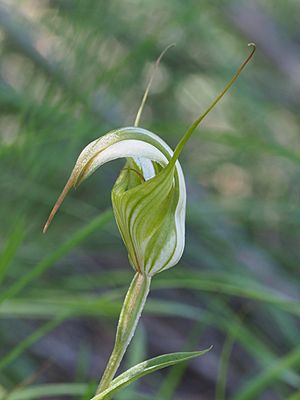Dainty greenhood facts for kids
Quick facts for kids Dainty greenhood |
|
|---|---|
 |
|
| Pterostylis reflexa at Apsley Falls | |
| Scientific classification | |
| Genus: |
Pterostylis
|
| Species: |
reflexa
|
| Synonyms | |
|
Diplodium reflexum (R.Br.) D.L.Jones & M.A.Clem. |
|
The Dainty Greenhood (Pterostylis reflexa) is a special type of orchid. It grows only in New South Wales, Australia. Like other greenhood orchids, it looks different depending on if it's flowering or not.
When it's not flowering, it has a circle of leaves flat on the ground. But when it flowers, it grows a single flower on a stem with leaves. This orchid has a pretty white, green, and light brown flower. It has a long, curved top part (called a sepal) and a part that sticks out (called a labellum).
What Does the Dainty Greenhood Look Like?
The Dainty Greenhood is a plant that grows from an underground tuber (like a small potato). It's a perennial plant, meaning it lives for more than two years. It's also deciduous, so some parts die back each year.
When it's not flowering, it has a rosette (a circle) of 3 to 7 egg-shaped leaves. These leaves lie flat on the ground. Each leaf is about 10–25 mm (0.4–1 in) long and 6–12 mm (0.2–0.5 in) wide.
When it flowers, it grows a single, curved flower. The flower is about 18–25 mm (0.7–1 in) long and 7–9 mm (0.3–0.4 in) wide. It grows on a stem that is 100–200 mm (4–8 in) tall. This stem also has 3 to 5 leaves on it.
The flowers are white, green, and light brown. The top sepal and petals join together to form a hood. This hood covers the central part of the flower, called the column. The top sepal has a narrow tip that is 4–6 mm (0.16–0.24 in) long.
The side sepals are close to the hood. They have long, thin tips that stand up, about 25–35 mm (0.98–1.4 in) long. There's a V-shaped gap between their bases. The labellum (the lip of the orchid) is 14–16 mm (0.55–0.63 in) long and about 4 mm (0.2 in) wide. It's reddish-brown and curved. About one-third of it sticks out from the flower.
These orchids usually flower from March to June.
How the Dainty Greenhood Got Its Name
The Dainty Greenhood, Pterostylis reflexa, was first officially described in 1810. This was done by a famous botanist named Robert Brown. He published his description in a book called Prodromus Florae Novae Hollandiae et Insulae Van Diemen.
The second part of its scientific name, reflexa, comes from a Latin word. It means "bent or turned back." This probably describes a feature of the flower.
Where Does the Dainty Greenhood Grow?
The Dainty Greenhood mainly grows on ridges and slopes. You can find it in forests near the coast of New South Wales. It grows in areas between Taree and Nowra.

